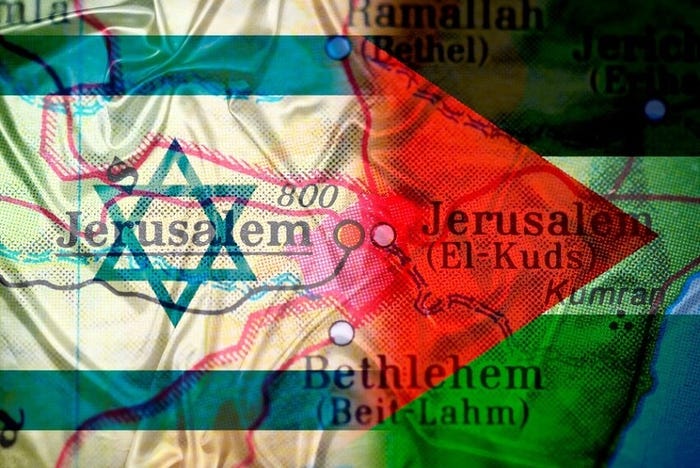IT & Trauma in the Gaza War

Editor’s Note: Below, are two feature articles, back to back — “How the Israeli Tech Sector is Coping With War” and “The State of IT in Gaza,” published together. The order of publication is no indication of the relative importance of each.
How the Israeli Tech Sector Is Coping With War
Israel’s tech sector is a primary contributor to the country’s economy. How are tech companies dealing with the crisis ensuing from the October 7th attacks?
As Israelis struggle to cope with the fallout from the Oct. 7, 2023 attacks by Hamas, the tech sector has leapt into action. From offering aid to employees directly affected by the crisis to assisting fledgling startups with investment support, industry leaders and junior employees alike have demonstrated a commitment to both the defense effort and the maintenance of the industry.
Tech is both a linchpin of the economy and a point of national pride. Last year, according to a report from the International Monetary Fund the industry brought in 18.1% of the country’s GDP — double the amount of that sector in the United States — and accounted for 48.3% of its exports. Some 40% of startups in recent years have revolved around technological innovation. Overall, the industry has been booming, nearly doubling in the past decade. Around half a million people are employed in tech-related positions — around 14% of Israel’s workforce.
Still, Israeli tech faced struggles even before the current crisis. Last year, startup investments almost halved in comparison to 2021. Companies in general have seen decreasing returns in comparison with similar companies on the NASDAQ exchange. The top 100 on NASDAQ saw 24% returns in the first quarter of 2023 while Israeli companies on average saw a decline of 1%. This has resulted in layoffs and decreased hiring across the tech sector.
Now, estimates suggest that around 15–20% of tech employees were recalled to service in the Israeli Defense Forces (IDF) by mid-October when 300,000 reservists were called into active service, most aged 35 and under. Some companies that rely on more experienced, and thus older, employees, have not been impacted. But startups employing younger people — especially in leadership positions — have been more acutely affected.
Nearly everyone in the industry knows someone who has died during the hostilities or been kidnapped or been called to active duty. Their colleagues have rallied around them and accommodations have become the norm — allowing care leave, working from home, or working part-time while on duty. Funds have been set up to solicit investment in companies that might otherwise flounder under these conditions.
InformationWeek checks in with industry leaders, including Alon Arvatz, CEO and founder of cybersecurity startup PointFive, Amit Bendov, CEO and Co-Founder of revenue intelligence firm Gong, Aaron Lazor, CEO of MyChargeBack, a company focused on forensic blockchain investigations, Guy Tytunovich, CEO of cybersecurity firm CHEQ, and Jason Wolf, CEO and cofounder of AI assistant startup Genie and cofounder of emergency assistance fund Iron Nation.
Impact On the Industry
Like all Israelis, tech workers across the nation report being deeply shaken by the attacks.
“Everyone here knows someone who was murdered, wounded, kidnapped or at least mobilized into the army in response,” Lazor reports.
“There is an immense amount of trauma and pain impacting this community,” Tytunovich adds. “That’s felt by our Israeli employees as well as our global team members who work closely with them day in and day out.”
After the initial shock faded, most companies report quickly returning to daily activities. While companies based in Tel Aviv and other cities adjacent to Gaza remain on high alert for possible shelling, others have been able to proceed with their daily activities without undue fear for their physical safety and the safety of their operations.
Still, some in the tech sector have expressed alarm at the prospect of future disruptions — if the conflict escalates or spills out into adjoining regions, for example.
Tomer Simon, chief scientist at Microsoft’s Israel R&D Center, said in an open letter:
“This concern is heightened amidst the background of the last 10 months in which a political storm took place that already had a bad effect on the confidence of foreign investments, and was even expressed in the closing of five R&D centers even before the beginning of the current crisis. This concern may cause multinational companies to freeze or reduce their investments after the conflict, and even to close their R&D activities here. Such actions would constitute a strategic retreat that would carry with it harmful results for Israel’s economic landscape and the future of innovation, weaken our global position and undermine our internal stability even more.”
The impact of staff recall to IDF service has been among the most significant current challenges. With some companies facing shortages of up to a fifth of their staff, operations have had to make challenging decisions about the sustainability of their operations and place increasing demands on remaining workers. The effect has varied, depending on the company and its staffing levels.
“In our company, we have 25 employees. Two were called up for duty,” Arvatz confides. “Two out of 25 is something that you can manage and absorb pretty easily. In other companies, there has been a bigger impact.”
That has been particularly true of startups. “In just the first couple of days, a lot of the top CEOs and founders were drafted,” Wolf says. “With startups it’s not like [it is in] a big company where someone can cover your back. You’re doing everything from pitching to get funding to selling the product. It stopped movement. Instantly.”
Even in the face of this anxiety, many tech leaders remain optimistic — both about near-term performance and the long-term prospects of their industry.
“We see ourselves as the ones leading the economy ahead in the long term,” Arvatz claims. “So we have a lot of responsibility on our shoulders.”
Employee Accommodations
Though business proceeds apace, companies have had to adjust to a new reality, both directly adjacent to the war zone and in other areas of the country.
“In the first week or so, it was very, very hard to work. Everyone was completely shocked,” Arvatz recalls. “What we tried to do in the first week as a company was to give people time to absorb, to digest.”
Work-from-home protocols were put in place by many organizations, allowing employees to care for their children and elderly relatives, especially if a spouse had been called to service in the IDF.
Lazor says that staff who reside in Tel Aviv and other areas that have been targeted by rockets are concerned about their safety while commuting, “but we already had a working plan for dealing with that,” he says. “We simply recycled our experience in dealing with COVID. Back then our employees operated from home when the country was on lockdown, and it went smoothly. So we have reverted to that same protocol for the commuters from afar, even those in Jerusalem, which has only been targeted a couple of times.”
In some cases, employees have begun returning to the office. In vulnerable areas, emergency protocols are already in place. So, if rockets are imminent, employees retreat to shelters and wait until the coast is clear.
Some companies, such as Gong, are assisting with childcare costs to facilitate the return to normal. Employees who were working abroad have been assisted with work permits and others whose homes have been disrupted by the conflict have been provided with temporary housing, Bendov adds.
Maintaining Business Continuity
Tech businesses are eager to point out that while the personal impact of the conflict has been significant, they remain able to provide services to their clients. Due to the volatility of the region, many already had protocols in place to ensure smooth service in the event of a disaster.
“Gong’s Israel-based employees are currently working remotely, and we have US and Dublin-based R&D resources available should the team need additional support,” Bendov notes. “Further, as part of our business continuity plan, we have Israel-based employees who have relocated outside the Middle East.”
Indeed, many companies have branches outside the country or are located in regions of Israel that are not as susceptible to attack.
“The general notion in the industry is that we have to continue to deliver our promise to our investors and to our customers. Israel really is here for the long haul,” Arvatz says. “And we also have to communicate that to everyone out there.”
Contributing to the War Effort
In addition to offering support to reservists on staff, many companies have allowed employees to volunteer during work hours in service of the war effort.
“Everyone is anxious to do something,” says Lazor. “As a company, we are no exception. We are allowing our employees to spend paid office hours on projects that directly benefit the soldiers, like helping a local restaurant prepare sandwiches that are shipped to them for free, volunteering to assist a local business that prepares and packages beef jerky that is also shipped to them for free, and volunteering to replace agricultural workers who were mobilized.”
Arvatz concurs, adding, “We found that there is a stated need, coming from the people directly, to impact and contribute to the effort.” His employees began volunteering once a week to assist those who had been impacted.
Providing Financial Support
The industry has also rallied around companies that are struggling in the current climate, offering investments under generous terms, as well as consulting on other necessary services that might otherwise be prohibitively expensive — everything from human resources to legal services.
While aid has been offered to companies of all sizes, the need has been especially dire for startups. Israel is home to a thriving tech startup ecosystem — some 6,000 are thought to be currently active, earning the country the nickname “Startup Nation.” But staffing shortages and investment hesitancy abroad have created the need for a concerted effort to keep fledgling startups afloat. Some 40% of staff have been diverted due to the war according to a recent survey by Start-up Nation Central.
A number of funds have emerged, among them Iron Nation, a venture capital-backed fund that aims to raise $20 million, to be invested in around 30 startups in need of assistance. The Israel Innovation Authority is matching those funds. The investments will be devoid of management fees and carried interest. Others, such as Safedome, have similar goals.
“The funding pretty much ground to a halt for these early-stage companies,” Wolf relates. “If we didn’t step in, it would be a catastrophe.”
Iron Nation will offer the recipients interim support, helping them maintain their momentum until they are able to operate on their own. They are intent on helping companies that already have established venture backing and are likely to succeed rather than companies that have not yet garnered funding on their own or companies that are already clear of the hazards that plague early startups.
“It’s like a plane taking off,” Wolf explains. “You can’t just stay in the air during that process. When you’re high up, you can hover a little, you can glide a little. When you’re on the ground, you can stay there. So we focused on companies that need the next six months to take off. We’re going to handhold them to the next stage.”
Struggling startups have inundated the fund with applications. “We have over 300 applicants, which is unbelievable. We thought we’d probably top off at about 150,” Wolf says.
“We’re gonna have to deploy the money in three to six months max,” he says. “The nine following years are going to be spent maximizing the management in the most efficient ways. We’re setting ourselves on a very aggressive goal of making sure that 80% of the companies we select succeed.”
New Vulnerabilities
While the tech industry has been quick to find its feet under these strenuous conditions, the cyber landscape as a whole is fraught with peril. Cyberattacks on individuals and organizations have increased in the wake of the October attacks — par for the course in an age where wars are fought on both physical and digital fronts.
Days after the attack, The Jerusalem Post’s website was taken down. Other Israeli news organizations were also targeted, comprising the majority of cyberattack victims. Check Point reported an increase in cyber attacks against Israeli targets, including SysJoker multi-platform backdoor attacks by Hamas-linked advanced persistent threat groups. It is often difficult to discern where attacks are coming from and which claims by hacker groups are accurate.
“We’ve seen a rise in DDoS attacks on websites of civilian infrastructure like hospitals, as well as on official government websites offering critical services,” Tytunovich says.
Alarmingly, the app Red Alert, which offers civilians notice of incoming missile attacks, was compromised. Users were given false notification that a nuclear attack was imminent. Fake social media profiles spreading false information and deceptive fundraising campaigns for victims of the Hamas attacks have also been observed.
As the war rages on, further cyber campaigns are inevitable. But the tech sector appears steadfast in its determination to power the economy and provide stability.
——-
The State of IT in Gaza
As the war continues, pressure on the region’s tenuous technological infrastructure has increased. What communication networks are available to Gazans — and how have they been impacted by the war?

mauritius images GmbH via Alamy Stock
Getting online or making a cellular phone call in the Gaza Strip is difficult these days — according to many reports, it’s essentially impossible. As hostilities continue in the wake of the October 7 attacks by Hamas, the Palestinian territory’s fragile technological infrastructure has become decreasingly functional.
Already weakened by Israeli military action during previous conflicts — and reliant on Israeli technology across the border — cellular and internet networks were unprepared to withstand further disturbance.
Damaged infrastructure and intentional throttling of access by Israel has taken many internet providers completely offline. Those that remain now provide only patchy service, if any at all, spurring a debate over whether the blackout constitutes acceptable wartime measures taken to protect the safety of Israeli troops or whether it is a human rights violation.
Media and humanitarian organizations embedded in the region claim to have lost contact with their staff, raising concerns for their continued safety. And citizens are unable to contact their families, within the region or abroad.
Here, InformationWeek explores the state of IT in the Gaza Strip, how it has been affected by the war with Israel, and what the situation looks like for people on the ground, with insights from Hanna Kreitem, a senior advisor for internet technology and development in the Middle East and Africa at the Internet Society, a nonprofit that promotes internet access around the world and Amanda Meng, a research scientist with the Internet Outage Detection and Analysis (IODA) project at the Georgia Institute of Technology.
Before War Started: The Standard of Internet and Cell Service
Internet and cellular phone service in the Gaza Strip depend heavily on Israeli infrastructure. The Strip is supplied with internet service by three fiber optic cables — all of which run through Israel.
Some 210 enterprises work in the tech sector in Gaza according to the United Nations Development Programme (UNDP). The number of internet providers in the region is unclear. An October report from the Internet Society suggests that of 51 networks operating in Palestine, 15 operate exclusively in Gaza; digital rights organization AccessNow says there are 19.
Before war started, around 92% of Gazan households had internet access, according to a 2023 labor force survey, though a UNDP report suggests that actual internet penetration was closer to 75%. Speeds averaged only around 26 Mbps.
“Broadband is available to most people over phone lines through ADSL connections,” Kreitem explains. “It’s not the greatest connection there because the infrastructure itself is a little bit outdated. There is fiber available in some places, but not everywhere.”
Phone service is more extensive, with 98% of the population having access to some form of telephone communication. But only 83% have cell phones and 58% have smartphones. There are two mobile providers, Jawwal and Oodedoo.
Nearly all customers operate on 2G because Israel has declined to allow upgrades to internet and cellular networks. Only materials for civilian use are allowed for import, but most are barred due to the possibility of dual use by military operations. Some users near the Israeli and Egyptian borders may be able to access 3G and 4G networks.
Technological deficiencies are further exacerbated by power cuts lasting 12–18 hours a day, even during peacetime. Two thirds of the power supplied to the Gaza Strip is from Israel, while the remaining third is supplied by a plant within the Strip itself.
Previous Disruptions
Earlier periods of hostility between Israel and Palestine have resulted in damage to the Gaza Strip’s infrastructure, contributing to the current instability. Most recently, a period of bombing in 2021 damaged aerial and ground cables. The Al-Jawhara tower, which housed various media agencies, and the Al-Jalaa tower, which housed media and telecommunications agencies, were bombed as well. Across the IT sector, costs amounted to nearly $9 million.
Some 56 IT companies were damaged and 13 were totally destroyed. Additionally, the offices of 40 IT companies were leveled. Paltel, one of the main distributors, was impacted at 272 locations, amounting to nearly $2.2 million in damage to that company alone. Their aerial cables were heaviest hit.
In 2008, an Israeli fuel blockade following a rocket attack from Gaza led to the shutdown of the region’s only power plant. Israel was also accused of shutting down internet access in 2011, though the country denied involvement in the blackout. And in 2014, the power plant was again targeted, as were supply lines from Israel.
Current Disruptions
Following the October 7 attacks, Israel began preparing for airstrikes and a later ground invasion in the Gaza Strip. Some of the strikes that ensued directly targeted communications infrastructure. The Al-Watan tower, which was home to internet provider AlfaNet, was destroyed on October 8. And one of Paltel’s offices was bombed the next day.
Three days after the Hamas attack, airstrikes had eliminated two of the three main lines of communication, severely limiting both cell and internet service.
In the following weeks, interruptions of the remaining service continued. Smaller networks had totally disappeared by the middle of the month.
“Most of the smaller ISPs don’t have multiple points of presence,” Kreitem notes. “They would have headquarters that include their offices and data centers, so any damage that occurs there will directly affect their network.”
Paltel noted that 83% of its users had been disconnected according to an October 19 United Nations Office for the Coordination of Humanitarian Affairs (OCHA) report. Paltel has some 2.5 million users, with over half in the Gaza Strip.
As Israel prepared for its ground invasion of the region on October 27, the company announced a complete blackout, as did its cellular subsidiary Jawwal.
This blackout was almost certainly intended to cut off communications to Hamas fighters as Israel targeted their operations. Some 36 hours later, the blackout was lifted, but additional shutdowns have since occurred during sensitive military operations. Paltel later announced that the October 27 blackout was due to an Israeli shutdown, as were blackouts on November 1 and 5. A fourth outage on November 16 was attributed to fuel loss.
“That’s usually how it is: The operators are really the ones with the most information as to how a shutdown is happening,” Meng observes.
Israel explicitly acknowledged its intent to cut off internet communications in a press release. By the end of the month, 15 of the 19 providers were shut down, affecting some 411,000 people, according to AccessNow.
By the middle of November, overall connectivity had reduced by at least 80% — or even less per IODA. Their data suggests that connectivity now hovers around 8–11% of what it is normally.
“In reality, it’s closer to zero,” Kreitem says. “Measurements are collected based on trying to reach IPs that are registered with ISPs with Autonomous System (AS) numbers that operate in the region. Many times these numbers are stated to be in Gaza, while they are actually used in the West Bank.”
IODA uses three types of monitoring to determine internet connectivity: Border Gateway Protocol (BGP), which assesses routing announcements; Telescope, which looks at unsolicited network traffic, also called internet background radiation; and active probing, which involves sending a ping to a network provider and awaiting a response.
“The internet wasn’t built to be measured, which is why we have to come up with lots of different ways to understand whether we’re seeing a disruption or not,” Meng explains. “When we look at our data, we want to see more than one signal show an abnormal pattern.”
“All three are showing heavy disruption to connectivity, with active probing being the signal that’s showing the complete shutdown outages.”
But Meng doesn’t think there is a total blackout. “There’s likely some kind of connectivity, but very limited,” she suggests. “It’s not a complete outage, but connectivity is severely degraded.”
Embargos on fuel and electricity delivery have further exacerbated the situation. Israel cut power immediately after the attack and the Strip’s only power plant had shut down due to lack of fuel by October 11.
Workarounds for these blackouts are very limited. Only large news organizations would have access to satellite phone technology, for example. Kreitem suggests that a small number of people may be using eSIMs, digital SIM cards that allow them to connect to networks outside of the Gaza Strip.
“I would say that’s still in the hundreds or the low thousands if it’s happening,” he says.
Debate Over Human Rights
Israel’s targeting of IT infrastructure has elicited a heated debate over whether such actions are acceptable during wartime or whether they constitute human rights violations.
Some cite documents such as a 2015 UN declaration, which says the following:
“Filtering of content on the Internet, using communications ‘kill switches’ (i.e., shutting down entire parts of communications systems) and the physical takeover of broadcasting stations are measures which can never be justified under human rights law.”
“Compounding the misery and suffering of civilians, Israeli strikes on telecommunications installations and subsequent Internet shutdown have effectively left Gazans with no way of knowing what is happening across Gaza and cut them off from the outside world,” United Nations High Commissioner for Human Rights Volker Türk said at the end of October.
Humanitarian organizations such as the Palestinian Red Crescent and OCHA have described difficulties in providing aid without communications technology. The World Health Organization (WHO), Médecins Sans Frontières and UNICEF made similar claims.
However, some have argued that targeting communications infrastructure that might aid Hamas is fair game during wartime, especially if it is done selectively — as appears to be the case in at least some of the blackouts.
Hamas targeted communications, too, knocking out communications towers before the October 7 assault. Communications are frequently targeted during conflicts, with one report documenting 931 blackouts between 2016 and 2021 in 74 different nations.
Critics have also pointed to what they see as violations of the 1995 Oslo Accords, which state that: “… the Palestinian side has the right to build and operate separate and independent communication systems and infrastructures including telecommunication networks, a television network and a radio network.”
While Palestinian territories do have their own networks, they argue that the agreement has not been upheld due to the heavy reliance on Israeli infrastructure — which has made it easier for Israel to throttle communications during wartime.




